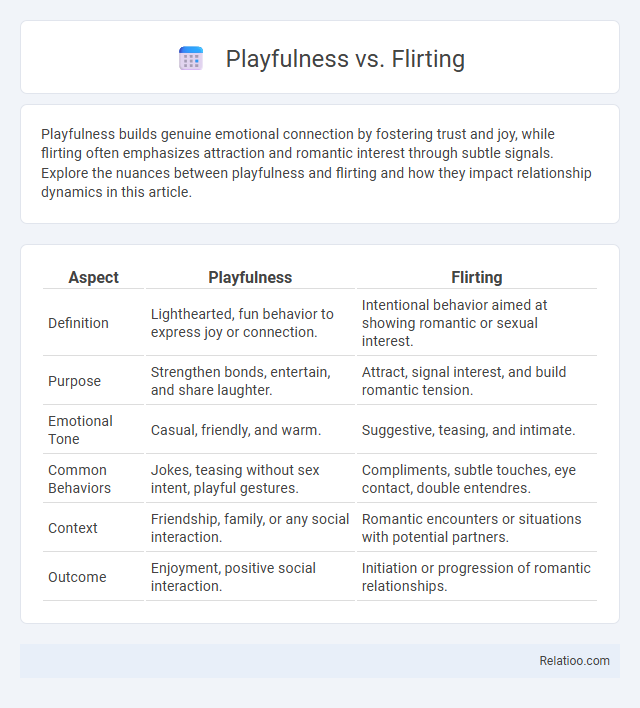Playfulness builds genuine emotional connection by fostering trust and joy, while flirting often emphasizes attraction and romantic interest through subtle signals. Explore the nuances between playfulness and flirting and how they impact relationship dynamics in this article.
Table of Comparison
| Aspect | Playfulness | Flirting |
|---|---|---|
| Definition | Lighthearted, fun behavior to express joy or connection. | Intentional behavior aimed at showing romantic or sexual interest. |
| Purpose | Strengthen bonds, entertain, and share laughter. | Attract, signal interest, and build romantic tension. |
| Emotional Tone | Casual, friendly, and warm. | Suggestive, teasing, and intimate. |
| Common Behaviors | Jokes, teasing without sex intent, playful gestures. | Compliments, subtle touches, eye contact, double entendres. |
| Context | Friendship, family, or any social interaction. | Romantic encounters or situations with potential partners. |
| Outcome | Enjoyment, positive social interaction. | Initiation or progression of romantic relationships. |
Understanding Playfulness: Definition and Traits
Understanding playfulness involves recognizing behaviors characterized by spontaneity, humor, and a lighthearted approach to interactions, distinguishing it from flirting which often carries romantic or sexual intent. Playfulness is expressed through creativity, laughter, and a willingness to engage in fun without an underlying agenda, making it a valuable trait in social bonding and stress relief. Your ability to embrace playfulness can enhance communication, foster positive relationships, and create an enjoyable atmosphere without necessarily signaling romantic interest.
What is Flirting? Key Characteristics
Flirting is a social behavior characterized by playful, often subtle, expressions of romantic or sexual interest, typically involving body language, eye contact, and teasing remarks. Key characteristics include intentional communication that signals attraction, ambiguous messages that maintain intrigue, and a lighthearted tone that invites reciprocal engagement. Unlike general playfulness, flirting specifically aims to create intimacy and connection while gauging the other person's interest.
Psychological Foundations of Playfulness and Flirting
Playfulness and flirting both stem from fundamental psychological drives rooted in social bonding and communication but differ in intent and expression; playfulness primarily promotes creativity, joy, and stress relief through spontaneous interaction, while flirting involves subtle cues to signal romantic or sexual interest. Neuropsychological studies indicate that playfulness activates reward circuits linked to dopamine, fostering positive social connections, whereas flirting engages both cognitive processes for interpreting social signals and emotional regulation systems to manage attraction and vulnerability. Understanding these psychological foundations reveals how individuals use playful behaviors to navigate social dynamics, balancing lighthearted interaction with underlying motives of connection and courtship.
Common Signs: How to Tell Playfulness from Flirting
Common signs distinguishing playfulness from flirting include body language cues such as prolonged eye contact, subtle touches, and genuine smiles that indicate flirting, while playful behavior often involves light teasing, joking, and casual interactions without romantic intent. Your ability to recognize these nuanced gestures, like an invited touch or a suggestive tone, helps differentiate playful interactions from flirtatious ones. Paying attention to context and consistency of behavior clarifies whether the intent is lighthearted fun or an expression of romantic interest.
Social Contexts for Playfulness vs Flirting
Playfulness in social contexts often signifies a lighthearted, friendly interaction aimed at building rapport and easing tension, while flirting specifically conveys romantic or sexual interest through subtle gestures and verbal cues. Playfulness can manifest in group settings without implying attraction, creating a fun and inclusive atmosphere, whereas flirting typically occurs in dyadic exchanges with an intent to attract. Understanding the distinction is crucial for interpreting behaviors accurately in various social environments, preventing miscommunication and fostering positive interpersonal dynamics.
Body Language Differences: Playful vs Flirtatious Cues
Playfulness in body language often includes relaxed gestures, open postures, and spontaneous smiles, signaling light-hearted engagement without romantic intent. Flirtatious cues typically involve prolonged eye contact, subtle touches, mirroring behaviors, and suggestive smiles that convey attraction and interest. Distinguishing between playful and flirtatious body language relies on context and the intensity of gestures, where flirtation emphasizes closeness and personal attention, while playfulness remains more casual and non-committal.
Cultural Perspectives on Playfulness and Flirting
Cultural perspectives significantly shape how playfulness and flirting are perceived and expressed, influencing social interactions and relationship dynamics. In some cultures, playfulness is seen as a harmless, friendly behavior promoting bonding, while flirting may be interpreted as a direct romantic invitation or even inappropriate, depending on societal norms. Understanding these cultural nuances helps you navigate social cues effectively and avoid misinterpretations in diverse settings.
Impact on Relationships: Playfulness vs Flirting
Playfulness fosters strong emotional bonds by encouraging genuine connection and shared joy, while flirting often serves as a tool for attraction and romantic interest, influencing initial relationship dynamics. Playfulness promotes long-term relationship satisfaction by enhancing trust and communication, whereas flirting can increase excitement and spark romantic attraction but may also introduce ambiguity if intentions are unclear. Understanding the distinct impacts of playfulness and flirting helps partners navigate intimacy and maintain healthy, balanced relationships.
Navigating Boundaries: Avoiding Misinterpretations
Navigating boundaries between playfulness, flirting, and teasing requires clear communication and sensitivity to context to avoid misinterpretations. Recognizing nonverbal cues such as body language and tone helps distinguish playful interactions from flirtatious advances or teasing that might cause discomfort. Establishing mutual consent and respecting personal limits ensures that interactions remain enjoyable and unambiguous, reducing the risk of misunderstanding or offense.
Tips for Communicating Intentions Clearly
Clear communication of intentions requires distinguishing playfulness, flirting, and teasing through tone, body language, and context to avoid misunderstandings. You can use direct verbal cues paired with positive nonverbal signals to ensure your playful or flirtatious behavior is interpreted correctly. Consistently checking for feedback and respecting boundaries enhances mutual understanding and comfort in social interactions.

Infographic: Playfulness vs Flirting
 relatioo.com
relatioo.com